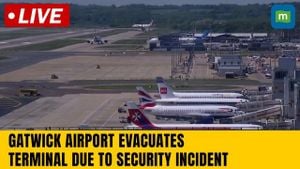The West Coast of the United States is currently experiencing one of the most significant weather events of the year, as atmospheric rivers and bomb cyclones converge to create severe conditions across Northern California. This dramatic shift from previous cold temperatures to torrential rains and heavy snowfall has left residents and officials scrambling to adapt and respond.
Beginning late Tuesday night, the first major storm of the season made landfall, bringing with it heavy precipitation and snow across various regions, especially the Sierra Nevada range. According to recent reports, areas north of Interstate 80 have felt the brunt of the storm, marking what meteorologists now recognize as the peak of this weather event.
On Friday, records began to tumble as rainfall surged. Sacramento, the region's capital, recorded 1.26 inches of rain by 4 p.m., breaking its previous record of 1.07 inches set back in 1978 on the same date. Such intense rainfall led to the issuance of Flood Advisories throughout the northern Sacramento Valley, alerting residents to the heightened risks of flooding and flash flooding before the Thanksgiving weekend.
With floodwaters rising, authorities focused on regions particularly vulnerable to debris flows and urban flooding, especially areas with compromised drainage systems. This included neighborhoods affected by burn scars, where the risk of runoff is significantly elevated.
The atmospheric river, which is known for transporting moisture from tropical regions, has brought not only rain but also snow to the Sierra. Snow elevations have increased throughout the week, with projections of significant snowfall amounts. By Monday, some areas were expected to receive as much as 1 to 3 feet of fresh snow, raising concerns about road safety and travel conditions as the holiday approaches.
The main concern for travelers this weekend is the potential for chain controls and difficult driving conditions, particularly across mountain passes. For those planning to travel during the Thanksgiving holiday, it’s imperative to stay updated on the weather and road conditions, as officials anticipate delays and difficult travel across the Sierra.
The National Weather Service has provided updates outlining very specific expected rainfall totals through the weekend. Predictions suggest the northern Sacramento Valley could see between 4 to 8 inches of rain, with lighter amounts expected south of the city. Areas like the San Joaquin Valley might receive between 1 to 3 inches, depending on shifts in the storm's path. The mountains will, of course, bear the heaviest of it, translating the high moisture content effectively to snow.
This type of storm system, referred to as both bomb cyclones and atmospheric rivers, has been associated with severe weather across the United States and can significantly affect daily life. Bomb cyclones, characterized by rapidly intensifying low-pressure systems, can generate strong winds and extreme precipitation. Meanwhile, atmospheric rivers like the one currently impacting the West Coast, are long, narrow bands of moisture-laden air originating from the tropics.
Knowing about these weather phenomena is helpful, especially as seasonal weather patterns evolve. The atmospheric rivers are frequently linked with warmer temperatures, which can lead to higher snow levels and increased rainfall rather than snowpack—essentially meaning more rain and less snow accumulation, which could create issues for water supplies later on.
With the coming days forecasting heavy moisture, residents are urged to stay up to date with local news and heed all warnings from the National Weather Service and local authorities. Flood possibilities loom, and emergency measures are being discussed as officials attempt to mitigate risks associated with the weather. No one wants to face the consequences of severe floods again like those experienced during past heavy storm seasons, where communities suffered damage and loss.
While weather events like these can be accompanied by significant challenges, they also serve as reminders of the need for preparedness—whether that's ensuring homes are ready for flooding, travel plans accommodate potential delays, or simply staying indoors when conditions worsen.
Overall, as Northern California braces for another round of heavy precipitation and snow, both government and community organizations work tirelessly to prepare for the imminent impacts. Reports suggest sustained efforts to address infrastructure vulnerabilities, improve drainage systems, and increase community awareness about the risks posed by such unpredictable and severe weather events.
Therefore, this weekend, as families gather and travel over the Thanksgiving holiday, weather conditions will undoubtedly shape their plans. The combination of atmospheric rivers and bomb cyclones this season may well test the resilience of California's infrastructure, but remaining alert and prepared can make all the difference.
It's always wise to check weather forecasts before heading out and follow local advisories closely. With the right information, residents can stay safe and effectively navigate the challenges presented by this significant winter storm.



